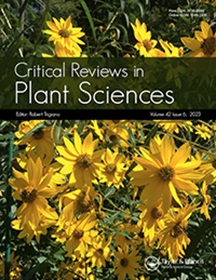Finger Millet (Eleusine coracana (L.) Gaertn): Nutritional Importance and Nutrient Transporters
IF 6
2区 生物学
Q1 PLANT SCIENCES
引用次数: 16
Abstract
Abstract Finger millet is a nutri-rich cereal crop of poor people living in the developing countries of Asia and Africa. Finger millet grains contain high amounts of potassium, phosphorus, magnesium, calcium, manganese, copper, zinc, and iron. Its calcium content is 10-fold higher than all other cereals and even three times higher than milk. Finger millet seeds are also rich in cystine, methionine, tryptophan, and total aromatic amino acids as compared to other cereals. Genome sequence of finger millet gives us the opportunity to study the nutrient transporters. No attempt has been made to analyze and improve the nutrient transport in finger millet based on the genome sequence. In this review, we discuss the nutritional importance of finger millet and report the details on key nutrient transporters for the first time. We have performed a genome-wide identification of various mineral nutrient transporters (nitrogen, ammonia, phosphorous, sulfur, potassium, and micronutrients) of finger millet and analyzed their protein sequences with those of various model cereals by various computational tools. Phylogenetic relationship of each nutrient transporter with those of other plants was analyzed and reviewed. The conserved and functional residues of nutrient transporters are analyzed through homology modeling and multiple sequence alignment using transporters with available crystal structures as templates and those from key cereals. This review may provide a foundation for further studies on these nutrient transporters and would help improve the nutrient transport in finger millet and other cereals to conserve food and nutrient security in the developing countries of Asia and Africa.手指小米(Eleusine coracana(L.)Gaertn):营养重要性和营养转运蛋白
小米是生活在亚洲和非洲发展中国家的贫困人口的一种营养丰富的谷物作物。指状谷粒含有大量的钾、磷、镁、钙、锰、铜、锌和铁。它的钙含量是所有其他谷物的10倍,甚至是牛奶的三倍。与其他谷物相比,手指小米种子还富含胱氨酸、蛋氨酸、色氨酸和总芳香氨基酸。小米的基因组序列为我们研究营养转运蛋白提供了机会。还没有尝试基于基因组序列来分析和改善指状小米的营养运输。在这篇综述中,我们讨论了小米的营养重要性,并首次报道了关键营养转运蛋白的详细信息。我们对手指小米的各种矿物质营养转运蛋白(氮、氨、磷、硫、钾和微量营养素)进行了全基因组鉴定,并通过各种计算工具分析了它们与各种模型谷物的蛋白质序列。对各种营养转运蛋白与其他植物的系统发育关系进行了分析和综述。使用具有可用晶体结构的转运蛋白和来自关键谷物的转运蛋白作为模板,通过同源建模和多序列比对分析营养转运蛋白的保守和功能残基。这篇综述可能为进一步研究这些营养转运蛋白奠定基础,并将有助于改善小米和其他谷物的营养转运,以保护亚洲和非洲发展中国家的粮食和营养安全。
本文章由计算机程序翻译,如有差异,请以英文原文为准。
求助全文
约1分钟内获得全文
求助全文
来源期刊
CiteScore
12.90
自引率
1.40%
发文量
15
审稿时长
>12 weeks
期刊介绍:
Critical Reviews in Plant Sciences focuses on presenting in-depth and up-to-date reviews of timely and/or cutting-edge subjects in the broad discipline of plant science, ranging from molecular biology/biochemistry through the areas of cell biology, plant pathology and physiology, genetics, classical botany, and ecology, to practical agricultural applications. Articles in the journal provide an up-to-date literature base for researchers and students, pointing the way towards future research needs. The journal is also a significant source of credible, objective information to aid decision makers at all levels.

 求助内容:
求助内容: 应助结果提醒方式:
应助结果提醒方式:


